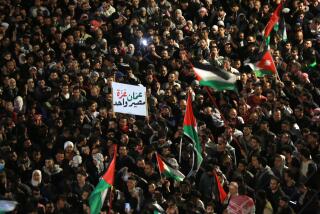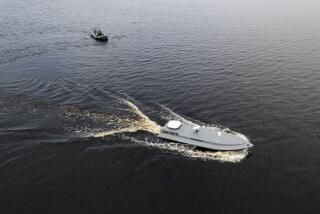Afghan Photos Sparked Inquiry
In a case that echoes the Abu Ghraib prison scandal in Iraq, U.S. soldiers in Afghanistan posed before cameras while threatening to shoot prisoners in the head, shoving a detainee into a wall and punching another inmate. The troops also mugged for “trophy shots” with the corpse of an enemy fighter who had invaded their camp last year.
According to military documents disclosed Thursday, the soldiers, fearing “another public outrage,” destroyed many of the photos and video images after photographs of prisoner abuse at Abu Ghraib were beamed around the world, resulting in widespread shock and criticism.
The remaining images were discovered by happenstance last year during the routine cleaning of a captain’s office at the Bagram air base in Afghanistan.
The photos -- apparently shot at a small base in the Central Asian country around the same time the abuses were occurring at the large Iraqi prison -- triggered an Army investigation centering on soldiers from a platoon within the 22nd Infantry Battalion, 10th Mountain Division, based at Ft. Drum, N.Y. The inquiry led to preliminary charges against eight soldiers for dereliction of duty after the Army decided more serious assault charges would not hold up.
It was unclear, however, whether the eight were ever prosecuted or disciplined. It was also unclear whether charges were brought against supervising officers in Afghanistan who admitted they had ordered the destruction of many of the photos after the Abu Ghraib scandal erupted.
The Army said Thursday when asked about the case that it remained “committed to addressing identified problems in detainee operations and to communicating the progress to the public.” Officials at the Pentagon, Army headquarters, the Army Criminal Investigation Command and at Ft. Drum did not respond to queries seeking more information about the status of the investigation.
Hundreds of pages of Army investigative records, made public Thursday as a result of a public records lawsuit by the American Civil Liberties Union, recount interrogations of dozens of soldiers who were confronted with the photos. Most admitted to military investigators that they were posing in them. Many acknowledged that their behavior was wrong.
The documents are the latest indication of alleged U.S. military abuse of detainees in Afghanistan. Military investigators are probing a December 2002 incident in which two detainees died after being captured and beaten.
Military investigators have also been looking into allegations of murder and torture involving an 18-year-old Afghan army recruit who died while in U.S. custody last year. The inquiry has also focused on the alleged torture of seven other Afghan soldiers.
At least eight prisoners have died in U.S. military custody in Afghanistan since the U.S.-led invasion in late 2001, according to military officials and documents.
In the newly disclosed case, the images are also said to show U.S. soldiers “hazing” fellow troops by dressing them up as detainees with their hands cuffed and sandbags over their heads, then dousing them with water and rolling them through mud. The soldiers said it was done to celebrate birthdays, promotions and New Year’s.
Although it is not known what activities were depicted in the destroyed photos, the surviving images from Firebase Tycz, near the Afghan village of Deh Rawod, do not show the kind of sexual humiliation of prisoners that was a hallmark of the sensational disclosures at Abu Ghraib. Also unlike Abu Ghraib, the Afghan case involved regular Army troops rather than reservists.
In Afghanistan and other military theaters, U.S. troops are allowed to take personal photographs but not shots of prisoners or other sensitive operations. Yet at Firebase Tycz, GIs routinely carried digital cameras, disposable cameras, camcorders and video cameras, and in interviews with investigators implied that almost everything they saw was memorialized on film or video.
The soldiers were investigated on suspicion of aggravated assault, maltreatment of detainees, obstruction of justice and failure to report crimes, the military documents show. Dozens of soldiers were interrogated at Ft. Drum in June and July about the incidents, which took place about a year ago.
The records indicate that two privates, four specialists, a sergeant and a staff sergeant were formally accused of dereliction of duty.
According to the records, the eight “committed the offense of dereliction of duty when as guards detailed to secure and protect detainees they willfully failed to perform their duties with no reasonable or justifiable excuse by jokingly pointing weapons at the bound detainees and exposed photographs of this unwarranted activity.”
However, accusations of aggravated assault were discounted in August by the chief of the staff judge advocate’s office at Ft. Drum. The captain “opined” that “aggravated assault did not occur” because the soldiers did not have the “intent to cause harm” while pointing weapons at detainees. Several of the soldiers said their weapons were unloaded when they aimed them at prisoners’ heads.
The officer also concluded that there was “no evidence to show the bound and hooded detainees were in fear for their life or even aware the weapons were pointed at them.”
It was unclear what happened, if anything, to soldiers who were described as being shown shoving or striking detainees, or taking the photos of the dead enemy soldier.
At the heart of the investigation were the images of soldiers pointing M4 rifles and 9-millimeter pistols at the heads and necks of detainees. Many soldiers said the photos were taken in fun.
Some soldiers were wearing helmets and masks in the pictures, making them difficult to identify. But others were identified by their clothing -- one wore a cap with the words “No Fear” on it; another was clad in a black sweatshirt sent to him by his girlfriend.
How do these photos make you feel? investigators asked an army specialist.
“Dumb thing to do,” he answered.
Another specialist was remorseful.
“I apologize for what I did,” he said. “It was wrong.... This was the first time I have seen the photo of me holding the weapon to the detainee’s head, and it is I in the photo, regretfully.”
Some defended themselves. “Pictures were taken of my soldiers mistreating PUCs [persons under control],” a sergeant said in a statement. “I have seen a few pictures of this nature before but thought nothing of it since these people are the ones that are trying to kill us.... These people might have been humiliated, but I am sure they were never in risk of losing [their] life while in our custody.”
A specialist who took some of the photos told investigators the “bad photos” were shot before the Abu Ghraib scandal erupted. He added that he “only became aware of this after the news broke on television and newspapers of the Iraqi incidents.”
What constituted a “bad photograph?” investigators asked.
“One where the public would be outraged,” he said.
Other soldiers said the photographs were commonly traded around the firebase. “It wasn’t something that we thought was wrong,” said a specialist. “Only something cool to have as a memory of our time there.”
The soldiers said they prepared two separate slide shows of their photographs from Afghanistan. The first showed soldiers relaxing. The other included the photos of soldiers threatening detainees, and of the corpse.
“One was for family and friends and the other was for members of our platoon,” explained a sergeant. “There were pictures of the dead guy on the platoon slide show, and you don’t want your kids seeing that kind of stuff.”
The pictures of the corpse were said to have been taken in January 2004 after a man fired a rocket-propelled grenade at a firebase watchtower, wounding three GIs. The attacker then ran onto the base firing an AK-47 and was felled by several shots to his chest and one to the head.
Photographs were taken of the body, and the interviews implied that soldiers mugged for the cameras. “These pictures were posed trophy shots,” said a first sergeant.
One of the photographers, a private, said his supervisor, a specialist, told him that he saw “nothing wrong” with taking the pictures “and let me in” close enough to get shots of the corpse.
Many of the photos in Afghanistan were shot around the time of the abuses in Abu Ghraib. The Iraqi prison scandal became public in spring 2004, and it appears that at that time, many of the Ft. Drum soldiers began destroying their pictures.
“After seeing the problems they had in Iraq, I knew this was a problem and should have never been done,” a specialist said of the picture-taking. “I realized there would be another public outrage if these photographs got out, so they were destroyed.”
He added that he “knew it was wrong after I [saw] the reports in the newspaper on the prison abuse scandal in Iraq.”
In another instance, a staff sergeant told a specialist to “get rid of the pictures” because he “believed someone might misinterpret them, [but] not because he thought they were criminal in nature.”
Another specialist “verbally counseled” a soldier and advised him to “get rid of” his photos.
“I told him and the rest of them that they should not do anything that they were not supposed to,” he said.
The ACLU also released documents Thursday detailing abuse investigations in Iraq involving alleged beatings of prisoners, including evidence that two soldiers punched and kicked a prisoner at a roadblock. In another incident, a prisoner complained that nonuniformed Americans beat him on the head and stomach and broke his nose.
*
(BEGIN TEXT OF INFOBOX)
An Afghan Abu Ghraib?
In a case like the Abu Ghraib prison scandal in Iraq, Army troops were questioned in July at Ft. Drum, N.Y., about incidents of alleged abuse in Afghanistan in late 2003 and early 2004. None of the soldiers is identified by name. Here are some of their responses:
* “At no time did I ever physically abuse any of the prisoners
* “I told him if he had any pictures that he was not supposed to have, to include bodies of the enemy, that he should not have them and get rid of them.”
* “I don’t feel any of the photos show physical abuse, nor do they imply physical abuse. The soldiers took a picture, or had a picture taken of them during a stressful time, where they were joking around. I don’t feel it warrants this kind of attention.”
* “The bad photos depicting fellow soldiers with prisoners were taken before the incident in Iraq, and after seeing the problems they had in Iraq, I knew this was a problem and should have never been done. I realized there would be another public outrage if these photographs got out, so they were destroyed.”
* “I apologize for what I did. It was wrong. I did not physically abuse anyone. This was the first time I have seen the photo of me holding the weapon to the detainee’s head, and it is I in the photo, regretfully.”
“This is a good platoon. Sgt. 1st Class ------- ran a tight ship; all his actions throughout the whole deployment kept us all alive and made us better soldiers. If he knew this was going on, he would have handled it.”
*
Source: U.S. Department of Defense
More to Read
Start your day right
Sign up for Essential California for news, features and recommendations from the L.A. Times and beyond in your inbox six days a week.
You may occasionally receive promotional content from the Los Angeles Times.







